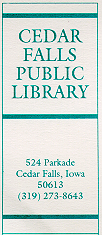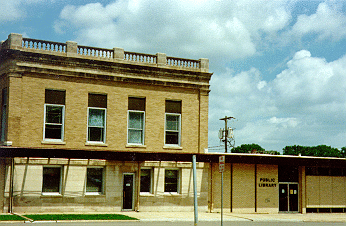The Context

Cedar Falls, with a population of 34,300, is situated on the banks of the Cedar River in northeastern Iowa’s Black Hawk County. It is a short drive from Waterloo, a city that is twice as large and is home to the headquarters and assembly plant of the John Deere Company, the nation’s largest tractor and farm machinery manufacturer. Both cities, which are nestled among the low hills and flat fields of large-scale farms and agricultural co-ops, have developed modest suburbs.
Although Waterloo and Cedar Falls share a newspaper (The Waterloo/Cedar Falls Courier), an airport, and the labor and retail establishments draw on regional markets, each city has its own distinctive character. Cedar Falls has its own local industries, manufacturing products such as rotary pumps and farm equipment, and is working to attract more commerce and business, especially high-technology industries. One of the main sources of its relative affluence, however, is the presence in the city of the University of Northern Iowa. The university enrolls about 12,500 students. The students, professionals, and faculty contribute to a lively economic environment–retail malls at the outskirts of town are busy, thriving places; the center of town is quieter but still very active. The turn-of-the-century town center is being restored and refurbished as part of a community-wide project to increase the city’s appeal to tourists.

The Cedar Falls Public Library occupies a 1903 Carnegie building with several later additions. All areas of the building are in heavy use and the library has no branches. The library director, Carol French Johnson, remarks that the library has outgrown the building. Together with the five other full-time professional and 12 support staff, she is hoping that voters will approve funding for the construction of a new building when it is placed on the ballot in the near future.
The mission of the library is “to provide, within the constraints of the budget, necessary resources, personnel and programming to meet the educational, informational and leisure time needs of the community.” To that end, the collections contain 91,000 items; 305,345 items were circulated in fiscal year 1995, and 23,213 reference questions were answered. The library spent $72,700 for print materials and $7,000 for electronic collections (leased, licensed, and purchased). Support per capita is $22.32. City funding for the library has remained stable, although the book budget is down from some years ago. Supplementary funding is provided by the Friends of the Library, which makes possible a summer reading program and young adult events.
The library is part of the Human and Leisure Services Department of the City of Cedar Falls and is governed by a working board of nine individuals appointed by the mayor. The university has a larger, and, one staff member remarked, “well funded” library (58 full-time staff; about 750,000 volumes), so students appear not to make much use of the public library. Given this situation, the director says it may have to work a bit harder than other libraries in cities of comparable size to show growth in library statistics, but the presence of the university does not affect the library’s service orientation, which is to the general public. Neither does the library expressly “market” itself to the college’s students and faculty.

